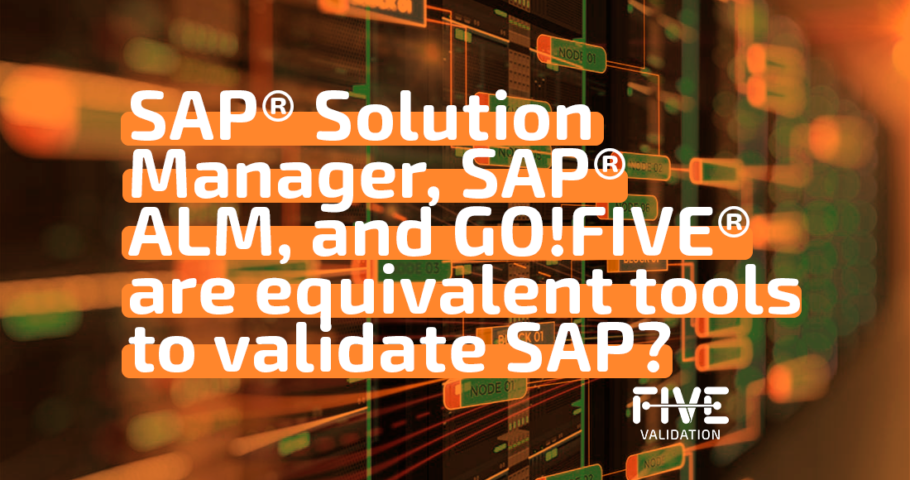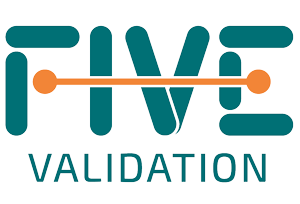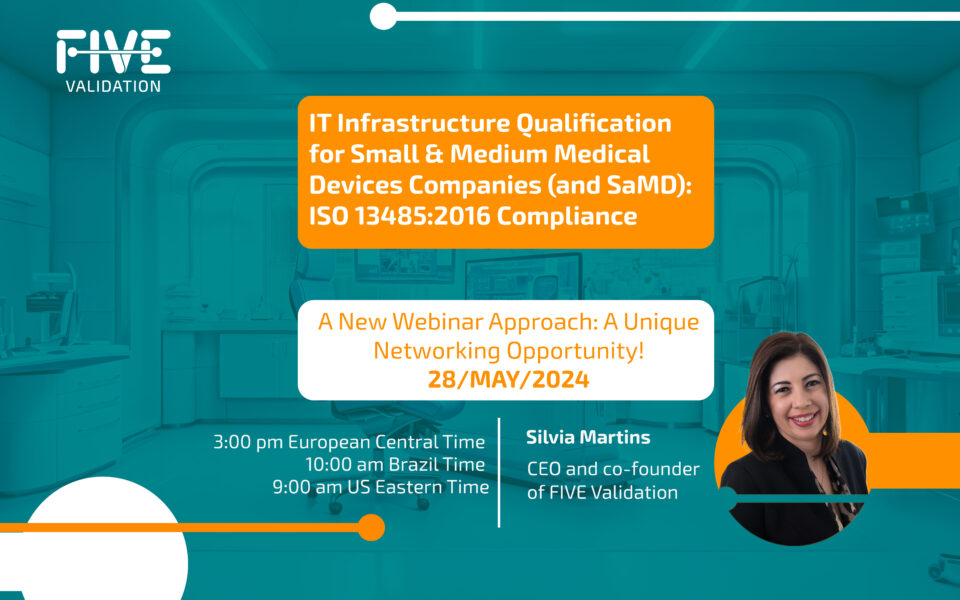SAP® Solution Manager, SAP® ALM, and GO!FIVE® are equivalent tools to validate SAP?

Many Life Science companies (Pharmaceuticals, Medical Devices, Biologics, and Diagnostics) use the SAP® platform as ERP (Enterprise Resource Planning) to manage their data and processes in an integrated way.
The implementation of an ERP is usually a highly complex project involving several professionals and areas, and its implementation is generally divided into a few phases.
In this article, we will address some solutions that SAP® provides to facilitate system implementation and discuss how the GO!FIVE® digital validation solution can complement this process, aiming to meet the specific regulatory requirements for this market segment.

Life Science companies operate in a highly regulated environment, i.e., FDA, EMA, and MDR (Medical Device Regulation), and need to prove and document that their products, systems, and manufacturing processes comply with regulatory requirements.
In this context, the objective of computer systems validation is to generate documentary evidence to prove that equipment, systems, spreadsheets, processes, and procedures are consistent with their intended use and conformance with regulatory requirements to protect patient or consumer, product quality, and data integrity.
ISPE® (International Society of Pharmaceutical Engineering) developed the GAMP Guide (Good Automated Manufacturing Practice) to guide the Life Sciences community in developing consistent validations.
Version 5 of the GAMP guide was released in 2008 and recently updated in 2022, bringing insights that can be very useful to a business.
SAP® Implementation Methodologies
There are several methodologies in the market related to project management, such as PMBOK and Scrum. However, for projects involving SAP®, the German company developed a specific process.
The first management methodology created by SAP® was ASAP® (Accelerate SAP) in 1990; that had five phases:
- Project planning.
- Blueprint.
- Realization.
- Final Preparation.
- GO live and support.

In 2015, with the arrival of the new version S/4 HANA®, there was the need to incorporate a new methodology, SAP Activate®. Among the most striking features is the adherence to the agile model.
- Discover
- Prepare
- Explore
- Realize
- Deploy
- Run
Although the ASAP methodology is still in use, there is a tendency for the SAP Activate methodology to consolidate itself as the standard methodology for SAP projects.
SAP® methodology encourages agile methodology.
ASAP and Activate are SAP® implementation methodologies.
Recently they updated and created SAP® Activate, which is very much in line with agile methodologies, which is the proposal of GO! FIVE®, cloud validation software, developed by FIVE Validation.
The methodology consists of guidelines on how to perform migrations or implementations. SAP® has roadmaps for various scenarios and suggests using tools in this process, for example, Solution Manager and ALM.
It is interesting to note that the implementation of SAP Solution Manager and SAP® ALM is a separate project that precedes the start of the ERP implementation project, requiring a lot of planning, anticipation, and budget for configuration efforts. Requiring configuration efforts to adapt the company's change management processes and GMP (Good Manufacturing Practices) rules adhering to the Life Science industries.
SAP Solution Manager, SAP ALM, and GO!FIVE®

SAP Solution Manager is a management solution that can help you model projects within SAP, whether implementing Greenfield, Brownfield, or Bluefield. In addition, it has features that allow you to document and represent business processes in the scope of migration or improvements that will be implemented.
SAP ALM allows you to perform automated and manual testing within the SAP application. However, it does not contain solutions designed to manage the complete validation cycle and apply rigor to each validation step, requiring configuration/customization to comply with these regulatory requirements.
Below, some points are not native to Solution Manager/SAP ALM:
- No formal pre-execution review/approval stage.
- No formal post-execution review/approval step.
- No field for evidence collection.
- No possibility for test witnesses to sign off on tests.
- The approach does not use risk management.
- No maintenance of requirements traceability, risk scenarios, and tests.
- No management of documents full cycle as recommended by GAMP5 Guide.
GO!FIVE® is a system specifically designed to manage the entire life cycle of validations and qualifications in compliance with regulatory requirements. It can generate dynamic reports (i.e., module, process, release) in the regulatory model accepted by bodies such as FDA and EMA.
GO!FIVE® is an off-the-shelf SaaS (Service as a Service) system that allows real-time remote management of all clients' validation/qualification projects. It is the only VLMS (Validation Lifecycle Management Software) platform on the market with content (requirements, risks, and tests) in the database.
Although SAP Solution Manager and ALM are useful, they have different functions/objectives than GO!FIVE®. Besides having pre-prepared validation templates, enabling 5x faster validations, the generated documents follow the regulatory model accepted by FDA and EMA and are also an excellent option to maintain the validated state after the go-live.
CSA tests - FDA and GAMP5
According to GAMP5, the overall extent of verification and level of documentation detail should be based on the risk to patient safety, product quality, and data integrity and focused on the intended use of the system. This approach is also similarly recommended by the CSA (Computer Software Assurance) guide issued by the FDA for quality assurance of software used throughout the manufacturing process and quality assurance of medical products.
The second edition of GAMP5 encourages testing to be more comprehensive than a detailed, prescriptive, step-by-step protocol. Therefore, it makes it more feasible to explain the testing strategy that the project team is applying. This approach can be justified in the Validation Plan or Test Protocol.

Tests foreseen by the project team can be addressed for lack of consistency in their evidence. However, the test script can be simple, especially tests related to transactions that are not critical and have low risk. However, it is still necessary to capture some data demonstrating that the test was/will be executed, how it was executed, who performed it, the date, problems faced in the test execution, and whether it passed or failed.
It is not a matter of accepting any lack of consistency in documentation by the project team, but with teamwork and documental best practices, they will be able to support the use of such tests.
Why not repeat or leave critical testing to the formal qualification phases of installation, operation, and performance so that quality is assured? In this case, using GO!FIVE® software, specifically designed to formalize approaches, strategies, and testing, adds expressive value.
Therefore, the level of test documentation required will vary depending on the risk associated with the feature/function. Traceability between test cases and requirements or specifications is essential to define the validation testing strategy.
For low risks of standard transactions, it is possible to decrease the documentation effort and use the SAP® solution for executing the tests. In this case, it is recommended that the document addresses the test executed within Solution Manager/SAP ALM to ensure traceability and the link to requirements and specifications.

Standard transactions with Good Practice impact (GxP relevant) with a low-risk result can have their tests performed in SAP SolMan and no longer need to be ignored for lack of consistency in their evidence. However, it is still necessary to capture some data demonstrating that the test was/will be executed, such as: who performed it, the date, problems faced when executing the test, and whether it passed or failed. However, the test script can be simple.
The following topics should have a more rigorous approach when conducting tests:
- Standard transactions with risks classified as medium or high.
- All relevant GxP custom transactions.
- All relevant GxP interfaces to other systems.

Remember that the validation study is not just about testing. A typical validation study for an ERP like SAP requires at least the following deliverables:
- URS (User Requirement Specification)
- Validation Plan (which includes Initial Risk Analysis)
- Functional Risk Analysis
- Hardware Design (or similar document that describes the physical and cloud infrastructure)
- Functional Specification (one or more similar documents describing the custom transactions and GxP interfaces with other systems)
- Installation Qualification (IQ) test protocol.
- Installation Qualification (IQ) test script.
- Installation Qualification (IQ) report.
- Operational Qualification (OQ) test protocol.
- Operational Qualification (OQ) test script.
- Operational Qualification (QO) Report.
- Performance Qualification (PQ) test protocol.
- Performance Qualification (PQ) test script.
- Performance Qualification (PQ) Report.
- Traceability Matrix.
- Final Validation Report.
Conclusion
SAP SolMan or SAP ALM was not explicitly developed for validation studies in the Life Science industry. Both tools have to undergo a lot of customization and configuration to perform the functions of GO!FIVE® software, designed to accelerate the conduct of validation studies, is ready to use and cost-effective.
Another beneficial use is for applying regression tests to identify points of improvement and validate changes, and then move on to the next challenge (perhaps the most difficult one): maintaining the validated state of the SAP system after go-live.
I hope you enjoyed this article. If you want to know more, please get in touch with us at [email protected] or schedule a meeting with our experts CLICK HERE.
SAP ECC and S/4 HANA software are registered trademarks of SAP in Germany and other countries. All rights reserved. For more details, access: https://www.sap.com/corporate/en/legal/trademark.html
Authors:
LÍLIAN RIBEIRO
- Sales Coordinator at FIVE Validation.
- Technical and commercial experience of almost four years in the food industry in the quality/quality control area and four years in the healthcare/pharmaceutical sectors.
- Enthusiast of paperless validation for life science companies.
- Experience in validation and qualification projects: VLMS, ERPs, EQMS, Automation (PW), and IT Infrastructure Qualification.
SILVIA MARTINS
- CEO and Co-Founder at FIVE Validation
- Electrical Engineer, 20 years of experience in System Validation. Trained in England in GAMP5 and FDA 21 CFR Part11, in Germany in SAP validation, and in Denmark in Data Integrity and Governance and coordinated the group that developed the 1st Guide for Computerized Systems Validation with ANVISA, Data Integrity Manual, and Cloud Supplier Qualification Manual at Sindusfarma. Provided training courses for VISA and ANVISA inspectors. CEO and co-founder of FIVE Validation.
Reviewer:
ROBERTO CORREA
- President and Co-Founder at Q6consulting LLC.
- Engineer and Business Administrator with over 40 years of experience in various leadership positions in leading companies in the medical devices market in Brazil, the United States, Mexico, and the Caribbean.
- Specialized in Quality Management Systems for regulated companies in the Life Science market.
References
- https://evoeducacao.com.br/artigos/sap-activate/
- https://www.techtarget.com/searchsap/tip/What-are-the-main-components-of-the-SAP-Activate-methodology;
- https://blogs.sap.com/2021/12/16/my-summary-of-sap-activate-for-s-4hana/;
- https://support.sap.com/en/alm/solution-manager.html;
- GAMP5 - Good Automated Manufacturing Practice: Guia de Validação de Sistemas Computadorizados, second edition, published by ISPE in July 2022.
- ISO 14971:2017, Risk Management Process.
- ICH Q9, Quality Risk Management.



